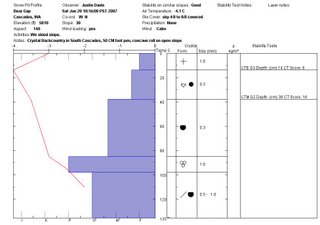Until last week, I had neglected to include a Rutschblock test.
First and foremost, this strikes me as odd, since it is my favorite test. For the uninitiated, this test is a continuation of your test pit, which is extended across the slope 2 meters, it is then cut back about 1.5 meters on either side and then the back is cut down to the same depth of the slope.
If a layer goes at this point it is considered a load of 1.
Next a skier gingerly stands on the top of the block, if it fails at this point it is a load of 2.
Then the skier makes some knee bends (partly weighting and unweighting the skis. If it fails here it is a 3.
The skier then jumps once, if it fails here it is a 4.
The skier then jumps again, failure at this point is a 5.
The skier is then replaced by a pedestrian jumping or stepping down to mid-block on skis and jumping some more, a failure here is a 6.
No failure at all is a 7.
I remember the rating scale as “Jump 4 joy” since a jump is a 4, and you are starting to get psyched once you get to a 4, a good little memory tool.
The summary in the OGRS is that a 1, 2 or 3 is unstable.
A score of 4 or 5, a slope is pretty suspect.
A score of 6 or 7, the risk of a skier trigger avalanche is considered to be low on that slope and possibly other, similar slopes.
This is a great test since it approximates the actions of a skier better than any other stability test other than a ski cut and it is fun and a good way to warm up after recording data in a hole in the snow. It is far from perfect and like all the other pit tests, can only be assumed to be 100% accurate for the immediate area of the pit, since we all ski slopes larger than 1.5 meters we need to evaluate the results of this test carefully and be sure that we do not over generalize.
Back to the reason for my omission of this test, a slope of at least 25 degrees is needed and 30 is greatly preferred. Another wacky rule of thumb is to subtract 1 for each 10 degrees of increased slope. For example a score of 4 from a test site at 32 degrees would translate to a 2 on a 52 degree slope nearby, which is a good rule if you can dig a safe pit on a 25 degree slope and can’t safely dig a pit on the 45 degree slope nearby which you want to ski if the results of your snow analysis are favorable.






